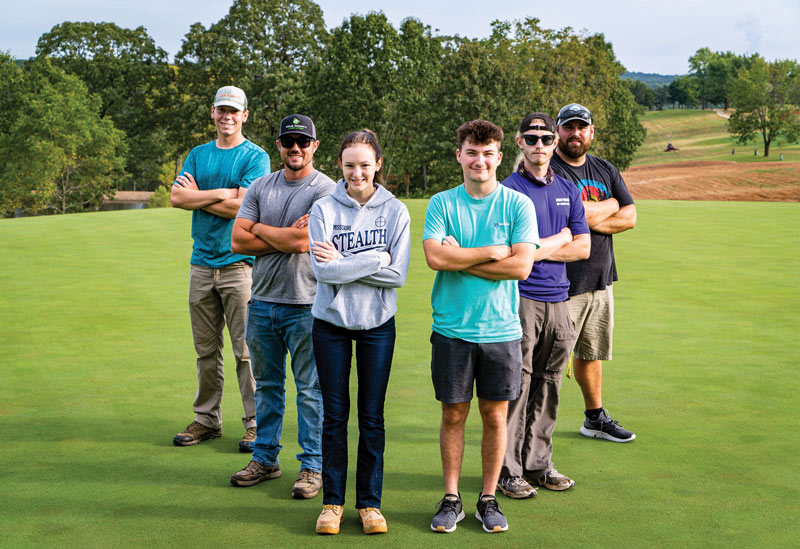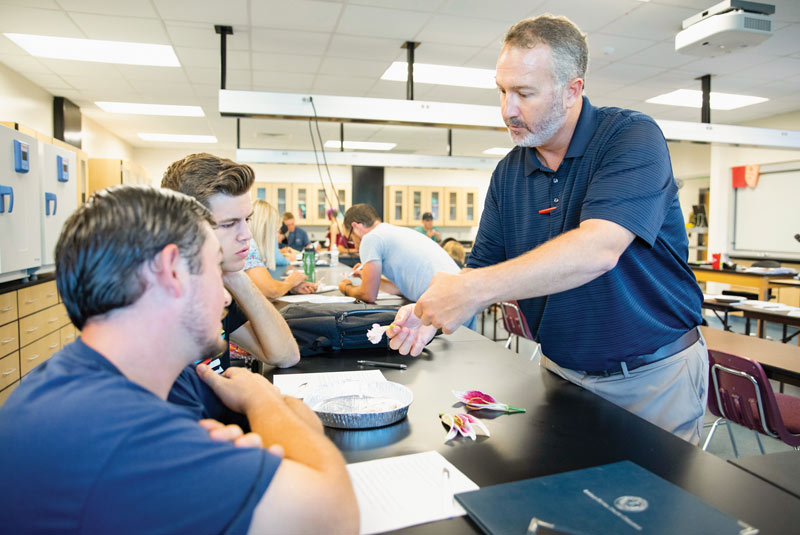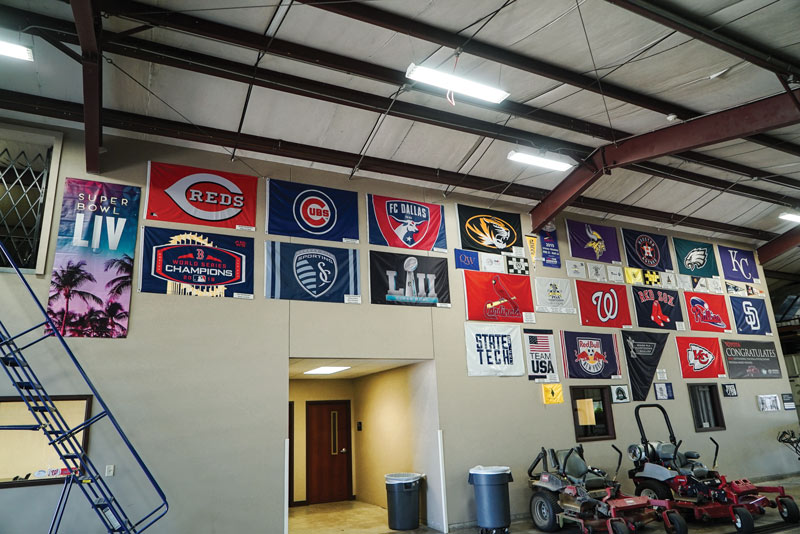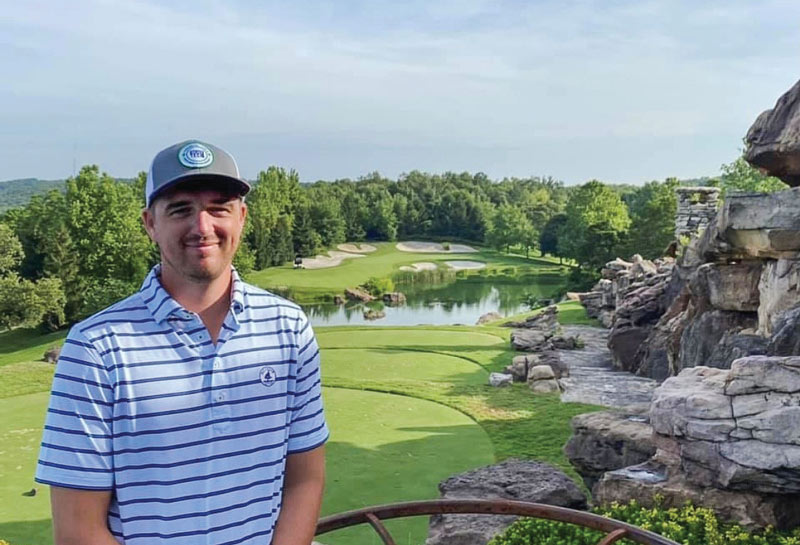
Current students and recent graduates of State Technical College of Missouri’s Commercial Turf and Grounds Management program (from left): William Rowe, Joe Miloro, Eliana Hardin, Clayton Strong, Josiah Prenger and Justin Wilt. Photo by Stephen Gilpin
Exiting his apartment, Sam Guerrero would observe a growing phenomenon at State Technical College of Missouri.
Guerrero watched as students like him would hop into their cars — sometimes alone, often in carpools — with trunks and back seats loaded with golf clubs. “They’d meet up after class, go play for an hour or so. The school has gone a little golf-crazy,” says Guerrero, who graduated last spring.
No wonder, then, that State Tech in Linn, Mo., which has about 1,600 residents and is located 30 miles southeast of Columbia, Mo., is helping populate the golf industry.
Its programs in Commercial Turf and Grounds Management (CTG) and Powersports Technology have cultivated professionals. And although there are no football, baseball or basketball teams at State Tech, some of its graduates own championship rings just like those of star athletes Patrick Mahomes and Mookie Betts. Several have become superintendents or assistant superintendents, and others serve on the equipment management staffs at golf courses.
State Tech may not be the largest turfgrass program, but it has no issues being a small college that dreams big. “Our college has grown 50% over the past five years (enrollment is approximately 2,000),” says State Tech President Shawn Strong, Ph.D. “I feel the reputation of the program, faculty leaders, the different golf courses and sports facilities where our students have gone, they know when they get a State Tech graduate, they’re getting the best. We see the opportunity to make something special here. When we see an opportunity, we like to go big.”
A turf management program takes root
When Ben Evers was chosen to be chairman of the newly launched horticulture and turfgrass management program at State Tech in 1994, the program shared a building with the aviation and heavy equipment programs. “The administration decided it (horticulture and turfgrass management) would fit in,” Evers says.
Evers recalls the first class had seven students. A significant decision in those early years sent the program on its way. “The administration made the brilliant decision to have 16-week internships that would start in March, and you couldn’t graduate without it, and it ensured you had some hands-on experience when you left,” says Evers, who departed State Tech in 2001 and is now general manager of Heartland Landscape Group in Lake Ozark, Mo. “The other part I thought was brilliant is that you’d be done (with school) in March, and (golf) courses didn’t have to wait until May for our students to get out.”


Course as classroom: Students Josiah Prenger (top) and Clayton Strong (bottom) at work at Osage Country Club, a nine-hole layout in Linn, Mo., that’s now operated by State Tech. Photos by Stephen Gilpin
A turning point, according to Evers, occurred a few years after he’d arrived at State Tech. Two of his students interned in 1997-98 at Southern Hills Country Club in Tulsa, Okla., working under Bob Randquist, CGCS, who is currently chief operating officer at GCSAA. The opportunity to work at a club rich in major championship history was significant, Evers says.
“He (Randquist) called me and said he loved those two kids. That opportunity was our ticket to building up our name. We fought for our reputation to build it up,” Evers says. “I told all our students that if their internships went nicely, they (golf facilities) are going to keep you or refer you someplace else. We weren’t a big name, but I told them you’re going to prove your worth. I’m not surprised how they are doing now. It started taking off, gained legitimacy, started being heard of.”
Smaller schools, same goals
State Tech isn’t alone. Other small colleges and junior colleges have found a niche in golf, and they’ve produced numerous industry standouts.
Among them is Carlos Arraya, CGCS, a graduate of Indian River State College in Fort Pierce, Fla. Arraya oversaw the PGA Championship in 2018 at Bellerive Country Club in St. Louis, and this past August, he was named the club’s general manager. Bellerive CC has been a landing spot for several State Tech CTG students over the years as interns, assistants-in-training and assistants.
As for his own college days, “I have a lot of pride in it. I got a great education. Look at me now,” says Arraya, a 22-year GCSAA member. He notes that Mike Platt, who started the golf course operations program at Indian River State in 1999 and is there still, made the difference in the careers of many. “He had a vision. Built it from the ground up. They need to put up a statue for that guy,” Arraya says. “I think they (Indian River) know who they are. They provide, at least from my perspective, a real feel in real time.”

Mike Platt, right, is a staple at Indian River State College in Fort Pierce, Fla., where he launched the golf course operations program in 1999. Photo by Molly Bartels/Indian River State College
Peter Ferlicca, a 10-year GCSAA member at superintendent at Trilogy Golf Club at Vistancia in Peoria, Ariz., attended College of the Desert in Palm Desert, Calif., where he earned a degree in turfgrass management after several years as an assistant golf pro at multiple clubs. “I enjoyed teaching golf and interacting with members,” Ferlicca says, “but when I had my first taste of working with turf, I found it to be a more gratifying job.”
Another small-college graduate making it big is Eddie Esgar. The 29-year association member is superintendent at Old Oak Country Club in Homer Glen, Ill., and attended Joliet (Ill.) Junior College. The program suited him perfectly. “I liked the small classes. I was one of about six students. It was a little more hands-on, a lot of one-on-one,” Esgar says.
It has a nice ring to it
There isn’t an official tally on which small college has churned out the most students who’ve received championship rings, but State Tech may be near the top of the list.
Three of its students — Zac Baladenski, Tyler Gosney and Blayne Murry — have rings after accompanying professional teams to the highest of heights. Baladenski was a grounds intern for the Boston Red Sox when the team won the World Series in 2018. Gosney and Murry are currently employed by the Kansas City Chiefs, winners of the 2020 Super Bowl.
Baladenski, a four-year GCSAA member who is now second assistant superintendent at A.L. Gustin Golf Course at the University of Missouri, has worn his ring once — when he married his wife, Madison. Baladenski worked for the Red Sox in summer 2018 and was allowed to rejoin the staff after school had started to be part of the World Series, during which he tended to the mound, mowed, watered, and painted World Series logos at Fenway Park. “I always wanted to be part of a big game,” Baladenski says. “For the World Series, everybody is watching.”
That State Tech allowed Baladenski to take time off to be part of it speaks volumes to the 2019 grad. “It says they’re looking out for you. They encourage you to pursue your career, your dreams,” Baladenski says.

State Tech’s Wall of Fame showcases places students in its turf program have worked as interns and professionals. Photo by Stephen Gilpin
Gosney, a 2014 State Tech graduate, interned with the San Diego Padres and Philadelphia Eagles, and later worked full time with the Minnesota Vikings. Before he was hired as assistant groundskeeper at Kansas City, Gosney interned for the Chiefs while earning a bachelor’s degree in plant science with an emphasis in turfgrass science through the University of Missouri. He works for Chiefs head groundskeeper Travis Hogan, who spent time as assistant golf course superintendent at Spyglass Hill Golf Course in Pebble Beach, Calif.
Progress report
They’re not satisfied at State Tech. That’s a good thing.
New offerings are on the way for the CTG program. Last year, the State Tech Foundation took ownership of the nine-hole Osage Country Club near campus, where students flock to play. State Tech is also in the process of building a multipurpose event complex on the golf course property. Part of it will feature an academic building with classrooms, a laboratory and a greenhouse. The back side will have 10 covered practice bays with Toptracer technology. The goal is to be open by the 2022-23 school year.
When Ryan Klatt, current department chair/instructor in the CTG program, arrived 20 years ago, those types of bells and whistles were nonexistent.
“When I got here, there weren’t facilities on campus for students to practice on, so the students and I built a 1,500-square-foot putting green right beside the greenhouse and installed an irrigation system on it. This gave the students something to mow and maintain,” says Klatt, a 29-year GCSAA member who spent 13 years at Jefferson City (Mo.) Country Club, including six years as assistant. “We also had 3 acres in the middle of campus. I pitched the idea of building a par-3 hole with a green and a tee, fairway and rough to manage. (Architect) Craig Schreiner drew up plans for free. This gave students access to a 6,500-square-foot green, short game area, two bunkers, fairway, mound, rough areas and an irrigation system.”

Ryan Klatt, department chair and instructor in the Commercial Turf and Grounds Management program at State Tech. Photo by Stephen Gilpin
Klatt praises program instructor Nick Rackers (whose landscape background includes time as a nursery manager and expertise in woody and herbaceous plants) for much of the heavy lifting that elevated the program. “When the main campus moved to the current location in the 1990s, the land was pasture and a former clay mine,” Rackers says. “There weren’t a lot of trees. I made it my goal to increase the tree and shrub diversity on campus. There still aren’t many old mature specimens of trees, but we are getting there. The same thing is happening at Osage CC. Over 50 trees were planted in spring 2021 to increase diversity away from a silver maple-dominant tree inventory. Rough areas are being converted to pollinator plots, and the first sowing of pollinator plots will happen this winter.”
The students who lead the maintenance at this happening place are what count to Klatt. “We’re blessed with a good group of kids. When you have good kids, they rub off on the other kids, and it makes them all better. Students made the program what it is,” Klatt says.
Osage CC also got a boost when State Tech partnered with MTI Distributing, a Toro dealer, for new equipment as part of a four-year deal beginning in 2022. That was welcome news for one-year GCSAA member Joe Miloro, a State Tech grad who is superintendent at Osage CC. “The golf course is a game-changer for our program,” says Miloro, whose staff includes three students who oversee bentgrass greens, zoysiagrass tees, bermudagrass fairways (currently being converted this fall to “bluemuda”), and bluegrass/fescue rough.
State Tech has sent graduates from its Powersports Technology program to golf facilities as well. The school connected several years ago with GCSAA through then-Bellerive CC equipment manager Chris Rapp, who proposed college curriculum development, student recruitment and exposure to golf maintenance. Rapp mentioned the idea to State Tech instructor Jason Finlay, who then worked with GCSAA to incorporate testing objectives for exams that support equipment manager competencies. The exams are now part of the students’ finals.

Justin Thomas, a State Tech graduate, is superintendent at Top of the Rock in Ridgedale, Mo., a Jack Nicklaus Signature Course. Photo courtesy of Justin Thomas
Cole Brenneke, a four-year GCSAA member, passed the exams. He started his new job as assistant mechanic/grounds crew member at Meadow Lake Acres Country Club in New Bloomfield, Mo., the day after he got his diploma from State Tech. His versatility had caught the eye of prospective employers, and he’d received a job offer before his final year of school had even begun. “If you know what you’re doing and pay attention, they find you,” Brenneke says.
Editor’s note: GCM has resources to assist you with every step of your job search, from preparing a résumé to interviewing to shining once you’re on the job. Get started.
Every fall, State Tech product Justin Thomas returns to the school’s career expo to mingle and recruit students for Top of the Rock in Ridgedale, Mo., where Thomas is the superintendent. A Wall of Fame at State Tech features flags from notable places its students and graduates have applied themselves, from pro teams’ venues to major golf events. Thomas’ Wall of Fame credits include the 2013 Senior PGA Championship and 2018 PGA Championship, both at Bellerive Country Club, and the Waste Management Phoenix Open at TPC Scottsdale in Scottsdale, Ariz. “The reputation and connections they (State Tech) have in this industry have allowed me to travel to places I never thought I would,” says Thomas, a seven-year GCSAA member.
In his second year at State Tech, student Josh Rippy is inspired by that Wall of Fame at the small college that has proved to be the start of something big for those who came before him. “The wall motivates me. It’s proof what we do here works,” Rippy says. “If they can make it, I can make it.”
Howard Richman is GCM’s associate editor.